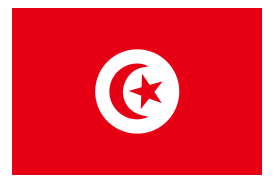Language/Tunisian-arabic/Culture/Modern-Tunisia-and-Geography
| ◀️ The Phoenician Period — Previous Lesson | Next Lesson — Negation Usage in Tunisian Arabic ▶️ |
Introduction[edit | edit source]
Welcome to the lesson "Modern Tunisia and Geography"! In this lesson, we will explore the modern geography of Tunisia and its impact on the country's people and culture. Understanding the geography of Tunisia is essential for gaining a comprehensive understanding of the Tunisian Arabic language and its context. By the end of this lesson, you will have a solid foundation in the geography of Tunisia and will be able to relate it to the language and culture of the country.
Geography of Tunisia[edit | edit source]
Tunisia is a North African country located on the Mediterranean coast. It is bordered by Algeria to the west and Libya to the southeast. The country has a diverse landscape that includes coastal plains, mountain ranges, and the Sahara Desert. The capital city of Tunisia is Tunis, which is located in the northern part of the country.
Tunisia is known for its beautiful beaches along the Mediterranean coast, such as the popular tourist destinations of Hammamet and Djerba. The country also has several mountain ranges, including the Atlas Mountains and the Tell Atlas, which provide stunning landscapes and opportunities for outdoor activities like hiking and skiing.
The Sahara Desert, located in southern Tunisia, covers a significant portion of the country's land area. It is the largest hot desert in the world and is known for its vast sand dunes and extreme temperatures. Despite its harsh conditions, the Sahara Desert is home to unique flora and fauna and has a rich cultural heritage.
Tunisia's geography has played a significant role in shaping its history and culture. The country's strategic location on the Mediterranean coast has made it a crossroads of civilizations throughout history. It has been influenced by Phoenician, Roman, Arab, Ottoman, and French cultures, among others. This diverse cultural heritage is reflected in the Tunisian Arabic language, which has borrowed words and phrases from these various influences.
Cultural Significance[edit | edit source]
Understanding the geography of Tunisia is crucial for understanding the cultural diversity within the country. The coastal regions have a strong Mediterranean influence, with a focus on fishing, agriculture, and tourism. The mountainous regions are known for their traditional Berber culture and agricultural practices. The desert regions are home to the nomadic Bedouin tribes, who have a unique way of life and cultural traditions.
Tunisian Arabic reflects this cultural diversity in its vocabulary and expressions. For example, the word for "beach" in Tunisian Arabic is "شاطي" (shaṭī), which is derived from the French word "plage." Similarly, the word for "mountain" in Tunisian Arabic is "جبل" (jebel), which is derived from the Berber word "adrar." These linguistic influences highlight the cultural interactions that have shaped Tunisia over the centuries.
Language and Geography Exercises[edit | edit source]
Now, let's practice what we've learned about Tunisian Arabic and its relationship to the geography of Tunisia. Complete the following exercises to reinforce your understanding:
Exercise 1: Vocabulary Matching Match the following Tunisian Arabic words with their English translations:
| Tunisian Arabic | Pronunciation | English |
|---|---|---|
| شاطي | shaṭī | a. Beach |
| جبل | jebel | b. Mountain |
| صحراوي | ṣaḥrāwī | c. Desert |
| ساحل | sāḥil | d. Coast |
Exercise 2: Describing Locations Using the vocabulary from Exercise 1, describe the following locations in Tunisian Arabic: 1. The beach in Hammamet 2. The mountain range in Kasserine 3. The desert in Tozeur
Exercise 3: Cultural Reflection Think about how the geography of Tunisia has influenced the culture and traditions of the country. Write a short paragraph in Tunisian Arabic describing one aspect of Tunisian culture that is influenced by the geography.
Solutions[edit | edit source]
Exercise 1: Vocabulary Matching
| Tunisian Arabic | Pronunciation | English |
|---|---|---|
| شاطي | shaṭī | a. Beach |
| جبل | jebel | b. Mountain |
| صحراوي | ṣaḥrāwī | c. Desert |
| ساحل | sāḥil | d. Coast |
Exercise 2: Describing Locations 1. The beach in Hammamet: الشاطي في الحمامات (esh-shaṭī fi el-ḥammāmāt) 2. The mountain range in Kasserine: جبال قصرين (jibāl kasrīn) 3. The desert in Tozeur: الصحراوي في توزر (eṣ-ṣaḥrāwī fi tūzr)
Exercise 3: Cultural Reflection The geography of Tunisia has influenced the traditional agricultural practices of the country. The fertile coastal plains and river valleys have allowed for the cultivation of crops such as olives, dates, and citrus fruits. This agricultural abundance is celebrated in Tunisian cuisine, which features dishes like couscous, brik, and mechouia that incorporate these locally grown ingredients.
Conclusion[edit | edit source]
In this lesson, we explored the modern geography of Tunisia and its impact on the country's people and culture. We learned about the diverse landscape of Tunisia, including its coastal plains, mountain ranges, and the Sahara Desert. We also discussed the cultural significance of Tunisia's geography and its influence on the Tunisian Arabic language. By understanding the geography of Tunisia, you have gained a deeper insight into the country's rich history and culture. Well done!
Other Lessons[edit | edit source]
- Traditional Food and Drink
- Contemporary Tunisian Writing and Poetry
- Popular Legends and Characters
- Traditional Tunisian Music
- Daily Life and Customs
- Traditional Crafts and Skills
- Independence Day and Other National Holidays
- The Phoenician Period
- Islamic Celebrations
Template:Tunisian-arabic-Page-Bottom
| ◀️ The Phoenician Period — Previous Lesson | Next Lesson — Negation Usage in Tunisian Arabic ▶️ |

